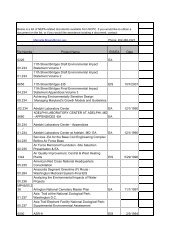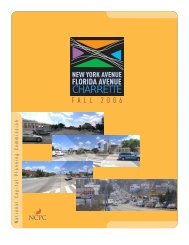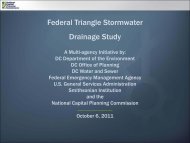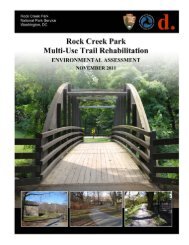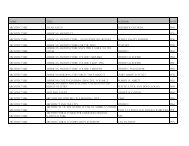Tetratech Interior Drainage Study for Potomac Park - National ...
Tetratech Interior Drainage Study for Potomac Park - National ...
Tetratech Interior Drainage Study for Potomac Park - National ...
Create successful ePaper yourself
Turn your PDF publications into a flip-book with our unique Google optimized e-Paper software.
MEMORANDUManalysis show that the ponding elevation and footprint are unaffected due to the relatively small volumeof storage in question.RainfallVarious rainfall frequency events were defined in the HMS model. The rainfall amounts wereinterpolated from the NOAA Atlas 14, Volume 2 and are shown below in Table 1. The SCS 24-hourType II rainfall distribution was used.Table 2. Precipitation DepthFrequencyPrecipitation(inches)100-year 8.3050-year 7.1510-year 4.802-year 3.14LossesUsing the SCS method, a curve number was defined <strong>for</strong> each of the sewersheds. Table 2 shows thevalues that were used <strong>for</strong> the land types found in the watershed. Based on visual inspection of the aerialphotography a composite <strong>for</strong> the sewershed was developed using the Table 2 values. The final curvenumbers ranged from 70 to 93.Land Type DescriptionTable 3. SCS Curve NumbersSCS CNUrban: Commercial 93Residential: 1/8 acre or less 89Open Space: Good 70RoutingLag times were developed within each sewershed to determine the time <strong>for</strong> the runoff to reach thecollection point of the sewershed. Flow Velocity was calculated based on the Manning’s equation:V = (1.49/n) x R 0.67 x S 0.5A Manning’s n-value of 0.013 was used to represent asphalt, a typical street section was used todetermine the hydraulic radius (R), and the slopes were identified from the topographic data. Times ofconcentration <strong>for</strong> each sewershed ranged from 2 minutes (5 minute minimum used in the analysis) to 19minutes. From the base of each sewershed routing reaches were identified along which to convey flow tothe low area in the Federal Triangle. Flow routes were determined through interpretation of the digitalelevation models topography as well as the CSO network in<strong>for</strong>mation.ReservoirThe reservoir component of the HEC-HMS model was used to determine the depth of ponding that wouldresult from the watershed runoff.Pond Outlet6



